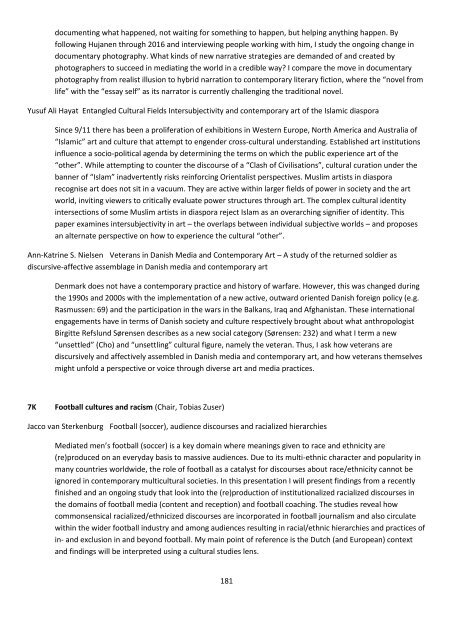Crossroads in Cultural Studies Conference 14-17th December 2016 Program Index
Crossroads-2016-final-draft-program-30-Nov
Crossroads-2016-final-draft-program-30-Nov
You also want an ePaper? Increase the reach of your titles
YUMPU automatically turns print PDFs into web optimized ePapers that Google loves.
document<strong>in</strong>g what happened, not wait<strong>in</strong>g for someth<strong>in</strong>g to happen, but help<strong>in</strong>g anyth<strong>in</strong>g happen. By<br />
follow<strong>in</strong>g Hujanen through <strong>2016</strong> and <strong>in</strong>terview<strong>in</strong>g people work<strong>in</strong>g with him, I study the ongo<strong>in</strong>g change <strong>in</strong><br />
documentary photography. What k<strong>in</strong>ds of new narrative strategies are demanded of and created by<br />
photographers to succeed <strong>in</strong> mediat<strong>in</strong>g the world <strong>in</strong> a credible way? I compare the move <strong>in</strong> documentary<br />
photography from realist illusion to hybrid narration to contemporary literary fiction, where the “novel from<br />
life” with the “essay self” as its narrator is currently challeng<strong>in</strong>g the traditional novel.<br />
Yusuf Ali Hayat Entangled <strong>Cultural</strong> Fields Intersubjectivity and contemporary art of the Islamic diaspora<br />
S<strong>in</strong>ce 9/11 there has been a proliferation of exhibitions <strong>in</strong> Western Europe, North America and Australia of<br />
“Islamic” art and culture that attempt to engender cross-cultural understand<strong>in</strong>g. Established art <strong>in</strong>stitutions<br />
<strong>in</strong>fluence a socio-political agenda by determ<strong>in</strong><strong>in</strong>g the terms on which the public experience art of the<br />
“other”. While attempt<strong>in</strong>g to counter the discourse of a “Clash of Civilisations”, cultural curation under the<br />
banner of “Islam” <strong>in</strong>advertently risks re<strong>in</strong>forc<strong>in</strong>g Orientalist perspectives. Muslim artists <strong>in</strong> diaspora<br />
recognise art does not sit <strong>in</strong> a vacuum. They are active with<strong>in</strong> larger fields of power <strong>in</strong> society and the art<br />
world, <strong>in</strong>vit<strong>in</strong>g viewers to critically evaluate power structures through art. The complex cultural identity<br />
<strong>in</strong>tersections of some Muslim artists <strong>in</strong> diaspora reject Islam as an overarch<strong>in</strong>g signifier of identity. This<br />
paper exam<strong>in</strong>es <strong>in</strong>tersubjectivity <strong>in</strong> art – the overlaps between <strong>in</strong>dividual subjective worlds – and proposes<br />
an alternate perspective on how to experience the cultural “other”.<br />
Ann-Katr<strong>in</strong>e S. Nielsen Veterans <strong>in</strong> Danish Media and Contemporary Art – A study of the returned soldier as<br />
discursive-affective assemblage <strong>in</strong> Danish media and contemporary art<br />
Denmark does not have a contemporary practice and history of warfare. However, this was changed dur<strong>in</strong>g<br />
the 1990s and 2000s with the implementation of a new active, outward oriented Danish foreign policy (e.g.<br />
Rasmussen: 69) and the participation <strong>in</strong> the wars <strong>in</strong> the Balkans, Iraq and Afghanistan. These <strong>in</strong>ternational<br />
engagements have <strong>in</strong> terms of Danish society and culture respectively brought about what anthropologist<br />
Birgitte Refslund Sørensen describes as a new social category (Sørensen: 232) and what I term a new<br />
“unsettled” (Cho) and “unsettl<strong>in</strong>g” cultural figure, namely the veteran. Thus, I ask how veterans are<br />
discursively and affectively assembled <strong>in</strong> Danish media and contemporary art, and how veterans themselves<br />
might unfold a perspective or voice through diverse art and media practices.<br />
7K<br />
Football cultures and racism (Chair, Tobias Zuser)<br />
Jacco van Sterkenburg Football (soccer), audience discourses and racialized hierarchies<br />
Mediated men’s football (soccer) is a key doma<strong>in</strong> where mean<strong>in</strong>gs given to race and ethnicity are<br />
(re)produced on an everyday basis to massive audiences. Due to its multi-ethnic character and popularity <strong>in</strong><br />
many countries worldwide, the role of football as a catalyst for discourses about race/ethnicity cannot be<br />
ignored <strong>in</strong> contemporary multicultural societies. In this presentation I will present f<strong>in</strong>d<strong>in</strong>gs from a recently<br />
f<strong>in</strong>ished and an ongo<strong>in</strong>g study that look <strong>in</strong>to the (re)production of <strong>in</strong>stitutionalized racialized discourses <strong>in</strong><br />
the doma<strong>in</strong>s of football media (content and reception) and football coach<strong>in</strong>g. The studies reveal how<br />
commonsensical racialized/ethnicized discourses are <strong>in</strong>corporated <strong>in</strong> football journalism and also circulate<br />
with<strong>in</strong> the wider football <strong>in</strong>dustry and among audiences result<strong>in</strong>g <strong>in</strong> racial/ethnic hierarchies and practices of<br />
<strong>in</strong>- and exclusion <strong>in</strong> and beyond football. My ma<strong>in</strong> po<strong>in</strong>t of reference is the Dutch (and European) context<br />
and f<strong>in</strong>d<strong>in</strong>gs will be <strong>in</strong>terpreted us<strong>in</strong>g a cultural studies lens.<br />
181


